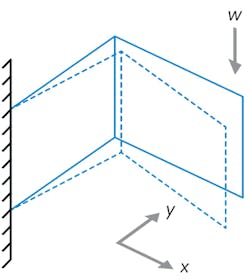Vibration Control: Low-frequency negative-stiffness isolation is compact for microscopy

ERIK RUNGE
Imaging molecules, materials, and interfaces at micro- and nanometer lengths can present a challenge for microscopy. Laboratory micro- and nanoanalysis techniques, such as atomic force microscopy (AFM), scanning tunneling microscopy (STM), superresolution optical microscopy, and advanced surface spectroscopy analysis methods such as surface-enhanced Raman scattering (SERS) are designed to maximize rigidity and minimize drift to affect accurate recordings. To achieve precise imaging of the composition, chemical makeup and behavior of these small structures requires that microscopy instruments be positioned in an ultrastable operating environment, one as free as possible of ambient and operational vibrations, as the measured signals can be influenced by frequencies ranging from lower than 1 Hz up to 400 Hz.
These vibrations can originate from wind, seismic activity, nearby construction and transportation, elevators, pumps, compressors, fans, motors, and air handling equipment for building heating, cooling, ventilation, and safety in laboratories. These sources contribute to ambient vibration throughout the building structure, which is transmitted through to the sensitive microscopy instrumentation. The vibration is typically more pronounced as the instrumentation is located at higher floors of the building, and when it is positioned closer to the source of the vibration.
A number of vibration-isolation systems have been used to diminish or eliminate the influence of these vibrations on sensitive microscopy instruments. These solutions range from relatively simple rubber blocks, metal springs, and bungee cord-suspended breadboards, to more sophisticated air tables, active electronic systems, and passive isolation systems constructed with more advanced technologies and materials for higher-precision vibration isolation at low frequencies.
Adaptable vibration isolation
Just as the nature of micro- and nanometer-level research necessitates a higher precision of low-frequency vibration isolation than what has been previously available with traditional techniques, so has this need demanded vibration isolation systems to provide a higher level of location flexibility and adaptability to space constraints (see Fig. 1).
Laboratory research floor space is increasingly at a premium. Scientists and engineers are required to site their instrumentation in a multitude of locations where vibration noise is significantly high. Scanning probe microscopes, interferometers, and stylus profilers are being set up in locations that pose a serious challenge to vibration isolation. Consequently, many academic and commercial research laboratories are not only inadequately providing for vibration isolation for their ultrasensitive microscopy instruments, but these systems lack the flexibility to adapt to diverse locations and space constraints.
The new benchmark for vibration isolation systems for micro- and nanomicroscopy can be defined as “universally adaptable.” This can be exemplified by three characteristics:
1. Low-frequency isolation in vibration-challenged locations;
2. Portable vibration isolation, without the need for power or air;
3. Adaptable for low-frequency vibration isolation within tight space constraints.
Of these factors, it is the capability to adapt to tight space constraints while isolating low-frequency vibrations that has not been available to microscopy laboratories until now.
Low-height, low-frequency platform mitigates space constraints
Given the closely monitored conditions required for controlled environments like vacuum chambers and cleanrooms, it is no wonder that every inch of space on breadboards and platforms supporting a laboratory’s precision microscopy instrumentation within these environments would be optimized to the fullest extent. Within these controlled environments, floor and benchtop space is likewise optimized. And microscopy laboratories operating outside of controlled environments are frequently functioning in confined parameters, with little room to spare.
Vibration isolation options for microscopy instrumentation in these environments has been limited to systems of several inches in height and higher, which for many an be too tall. This can make for tight working conditions and limit the instrumentation that can be included on the breadboards and platforms.
A negative-stiffness vibration isolation tabletop platform from Minus K Technology considerably alleviates this space-constraint issue, as its design permits it to have a height of only 2.25 in. The platform, called the CT-1, has a 0.5 Hz vertical natural frequency and 2–2.25 Hz horizontal natural frequencies (Minus K is researching even lower horizontal natural frequencies)—these are considerably lower figures than the vibration isolation performance of air tables and active systems.
Negative-stiffness isolators rely on an entirely mechanical concept to achieve low-frequency vibration isolation (see Fig. 2). The passive mechanical mode eliminates the need for electricity or compressed air—there are no motors, pumps or chambers, and no maintenance because there is nothing to wear out.In negative-stiffness vibration isolation, vertical-motion isolation is provided by a stiff spring that supports a weight load, combined with a negative-stiffness mechanism. The net vertical stiffness is made very low without affecting the static load-supporting capability of the spring. Special flexures connected in series with the vertical-motion isolator enable the very low-height, horizontal-motion isolation. The result is a compact passive isolator capable of low vertical and horizontal natural frequencies and high internal structural frequencies.
The isolator achieves a high level of isolation in multiple directions and has the flexibility of allowing custom tailoring of resonant frequencies vertically and horizontally. The fact that the isolator operates entirely flexurally, and not translationally (which can exhibit stick-slip, frictional behavior), allows the isolator to operate in extremely low-vibration environments that would not be practical with top-performance air tables and other vibration-mitigation technologies such as active systems.
The vibration that is transmitted through the isolator measured as a function of floor vibrations is called transmissibility. The transmissibility of the negative-stiffness isolator is substantially improved over air and active isolation systems: when adjusted to a 0.5 Hz vertical natural frequency, the negative-stiffness isolator achieves approximately 93% isolation efficiency at 2 Hz, 99% at 5 Hz, and 99.7% at 10 Hz.
Negative-stiffness vibration isolation systems have become a growing choice for micro- and nanotechnology microscopy applications. Not only are they a highly workable vibration solution, but they provide location flexibility and portability that other vibration isolation systems cannot.
Erik Runge is Director of Engineering at Minus K Technology, Inglewood, CA; e-mail: [email protected]; www.minusk.com.
